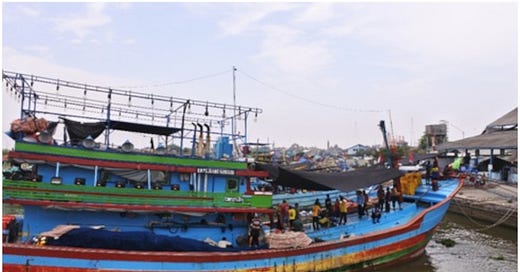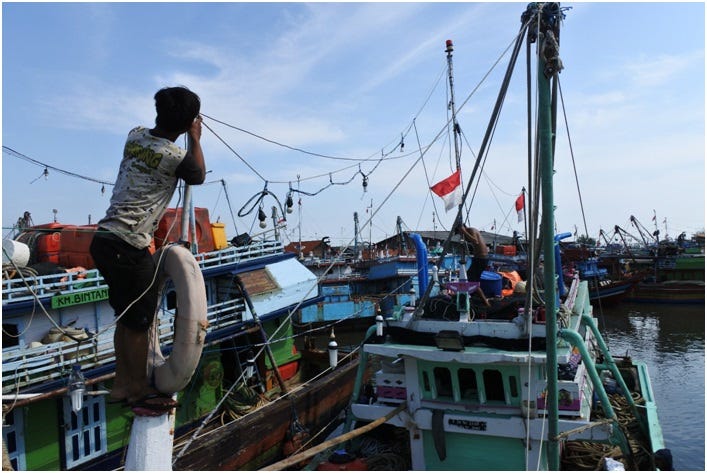By: Ainur Rohmah
The night was getting late but a group of fishermen were still busy preparing equipment and supplies for the 250-gross tonne KM Satria Tambah Makmur, docked at Juwana Harbor in Central Java. The head of the ship's engine room, 25-year-old Dimas Bagaskara went back and forth to check the supplies of fuel and safety equipment that they would take to sail the next day. Occasionally he joked with his comrades just to keep them awake.
"Before leaving for the sea, it feels a bit sad to leave the family," Dimas said. "But this is our job, so we have to do it."
The Satria Tambah Makmur would take Dimas and 49 other fishermen to sea for at least the next eight months —a full season. They were to leave Juwana Harbor to anchor on the morning of September 14 in the Arafura Sea, where they would begin their search for tuna, skipjack, and mackerel, which are then exported to countries in Asia. The deep waters, which occupy 250,000 square miles between Australia and Papua, are a destination for vessels weighing more than 100 gross tonnes, as the Satria Tambah Makmur does. But they are growing more treacherous, fishermen say, as climate change drives up sea temperatures and raises the incidence of intensive squalls that have taken an increasing number of lives and cut into the amount of time vessels can stay on the fishing grounds rather than having to shelter in the lee of nearby islands.
Arafura waters, Dimas said, are known to have strong currents with weather conditions there that can change at any time. Officials warn that “Wind gusts can be 40 percent stronger than the forecast, and stronger still in squalls and thunderstorms. “Wave heights can reach 6 meters with wind speeds ranging from five to 25 knots, enough to make the ship toss and even raising the possibility of an accident. But this is where the fish are. Around 21 percent of Indonesia's fish potential is found in Arafura waters – 2.64 million tonnes per year, based on data from the Ministry of Maritime Affairs and Fisheries. At least 12,000 fishing vessels operate in the Arafura Sea per year, raising concerns about illegal fishing and overfishing in the waters. It is what keeps the Satria Tambah Makmur in these waters, rough seas or not.
"Because of the waves, my boat once leaked and I and other fishermen had to drain the water overnight so it didn't get higher," Dimas said. His colleague, Mohamad Hadi Susilo said bad weather is the most common challenge he faces while fishing in Arafura.
"If I face such bad weather, I can only pray," said Hadi. While waiting for the calm weather to return, he said, fishermen usually pull over into the lee side of a nearby island. "But even that is now uncertain how long the weather will return to normal," said the 30-year-old.
Although there is no guarantee that they will return home safely, the Timor and Arafura sea area has abundant marine products, which are even dubbed 'the golden fishing ground', thus luring fishermen like Dimas and Hadi to keep coming there. Although the work as fishermen is still promising, they complain that the weather at sea is now increasingly difficult to predict, which affects their catch. "In turn, this affects our income," said Dimas. While in 2015 low-ranking crew members easily earned Rp17 million (US$1,120) for one month, now they are lucky if they can earn Rp30 million for a season.
Fishermen on the island of Java usually rely on what is known as "ilmu titen", or sensitivity to signs or natural characteristics which are then used as guidelines in farming or fishing. They are accustomed to using the Pranata Mangsa (seasonal determination) guidelines, which are calendars compiled based on indicators of natural phenomena to determine the start of the fishing season for fishermen and planting for farmers. they are also used to reading natural signs such as rainbow patterns and the direction of lightning to predict the arrival of storms or winds.
However, extreme seasonal changes have resulted in predictions of the appearance of the Waluku Star or the Constellation Orion, which are the benchmarks for determining the seasons, often missed. "We still often use 'ilmu titen' when we go to sea, but now it's often not appropriate," said Dimas.
Hadi said the loss due to the erratic weather was substantial for fishermen. "Losses can reach billions in a season," he said. For one season, a group of fishermen and the ship owner must spend around Rp3 billion for supplies and other needs. When bad weather hits, they do not work while their supplies such as diesel and food run low.
Hadi said that although he still often uses traditional methods to predict the weather, his team also follows weather predictions from the Meteorology, Climatology, and Geophysics Agency (BMKG). "But even then it is sometimes not right. For example, high waves are predicted to come today, but in reality, it could be a day sooner or later. We at sea are confused," he said.
Sugeng Nugroho, administrator of the Indonesian Traditional Fishermen Association (KNTI) said many members have complained about the sudden bad weather at sea increasing the risk of accidents. "We often receive reports of incidents of boat sinking, boats leaking or breaking because of the waves. Not only in the deep sea east of Indonesia, but similar incidents often occur in other marine areas," said Sugeng.
Although research must be carried out to find more detailed data and facts, Sugeng believes that the climate crisis has negatively affected fishermen's work, increasing the difficulty of fishing as well as the risk of accidents at sea. Recently, for example, KM Setia Makmur sank in the waters of Arafura in July. Of the 21 crew members, seven survived and 14 remain missing and are presumed drowned. Reports said that bad weather and high waves were the main factors.
Data from the Indonesian Forum for the Environment (WALHI) state that the climate crisis has resulted in an increase in the number of deaths of fishermen. At least 251 fishermen died at sea in 2020, almost three times compared to 2010 which was only 86. Data from the National Transportation Safety Commission (KNKT) show the incidence of accidents at sea in the 2018-2020 period is dominated by fishing vessels, which accounted for 31 percent of the 76 accidents. However, this is thought to be an iceberg phenomenon. Based on Government Regulation No. 62/2013 concerning Transportation Accident Investigations, the NTSC is only ordered to investigate accidents with ships weighing more than 100 gross tonnes. In fact, the number of shipwrecks with a capacity of under that weight was estimated at 400 incidents in the same period.
According to WALHI, the climate crisis has also limited the time fishermen are able to go to sea, cutting it to six months per year, cutting into their income, and impairing their social and economic lives, causing some to switch professions. According to KKP data, the number of Indonesian fishermen in 2017, estimated at 2.67 million, declined to 2.64 million in 2018 and 2.39 million in 2019.
The sun was just rising when 'KM Satria Tambah Makmur' took Dimas and Hadi away from the beach. The days are tiring, boring, and perhaps stressful they will pass throughout this fishing season. However, when the net is full of fish, said Dimas, it is a happy time. "Maybe the challenges ahead for fishermen will be more difficult. But what I can do now, I will do my best."
Ainur Rahmah writes regularly for Asia Sentinel. This was made possible by a grant from the Arafura and Timor Seas Ecosystem Action Program (ATSEA) Part 2 will appear tomorrow. Photos by Dhani Setiawan






Fabulous story. Thx
Excellent reporting on the plight of fishermen. It's a perilous life for them. It's not only climate change that strains life lines for the industry but there are threats from other fishing vessels and increased piracy. My book, Dispatches from the South China Sea: Navigating to Common Ground did not capture the Indonesian story, so I am appreciative of this series.